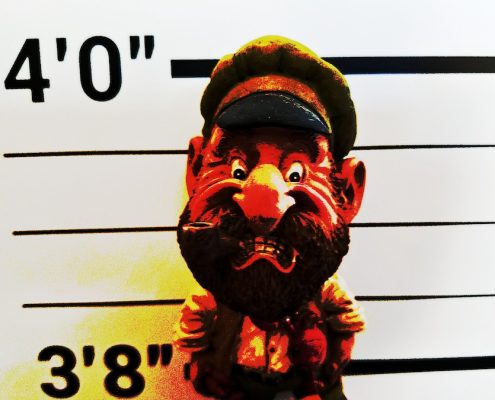The hero of your story had a long night answering call after call—he-saids, she-saids, chasing a Peeping Tom through back yards and alleys, a couple of drunks arguing over a near-empty bottle of Ripple, kids spray-painting Smiley Faces on stop signs, and the guy zooming on meth who insisted he was Jesus and attempted to prove it by damning you to hell a few dozen times after you refused to give him ten dollars “for food.”.
Yep, a looonnnggg night and it was only half over when Jimmy Bob “Peanut” Lawson, Jr. decided to join forces with his good friend Jack Daniels to blacken both of his wife’s eyes.
Well, Earlene, the wife, wasn’t about to stand for that so she poked ‘ol Peanut in the gut a couple of times with a dull carving knife. Didn’t break the skin, mind you, but the act was just enough to send Peanut off the deep end. Oh, he was plenty mad about it, yellin’ and screamin’ and stompin’ his Doc Martens across the kitchen linoleum, kicking at Porkchop, the family’s three-legged dog. But Porkchop, having been to this freak show one too many times in the past, knew to stay ten or twelve dog-dish-lengths away from his master’s size twelves.
After several minutes of plate, bowl, and pot-and-pan-throwing, one of the kids, a snot-nosed, freckle-faced boy of around ten or so, picked up the cordless and punched the speed dial button for 911.
So your character shows up, and Peanut, a Friday night regular, meets her in the driveway, huffing and puffing like an old coal-fired locomotive engine.
Now here’s where things could get a little dicey, so it’s best to run down the unwritten checklist your hero keeps tucked away in her head. You know, size him up. Is he armed? Is he really going to attack? Or, is all that chest-thumping and Tarzan-yelling just a show for the neighbors? Well, she’d better find out in a hurry because Peanut’s starting to spin like the Tasmanian Devil cartoon character.
How can you tell if this guy means business, or not? Well, let’s have a quick peek at the telltale signs that most crooks offer that’ll help you evaluate the situation.
Since weapons and other items that are capable of puncturing your flesh are your first concern, here are some common indicators that Peanut is carrying a hidden gun or knife. For example:
1. It’s 97 degrees outside and Peanut is wearing his heavily-insulated, blood-stained orange hunting jacket. Yes, Einstein, he’s probably wearing it to hide a sawed-off shotgun, the one Daddy gave him for Christmas when he was three. The chew marks on the stock are proof the gun was a go-to favorite during teething (his mama says he loved to bite and chew on anything that would fit in his pie hole).
2. The tail of his flannel shirt is out, but one side is riding higher than the other. A great sign that he’s wearing a weapon on the “high side.”
3. Sometimes, wearing a shirt tail on the outside is a sign that he might be carrying a weapon. Unfortunately, it’s also a sign to crooks, which means they might recognize you as an undercover officer.
Now, for the signs that Peanut is about to attempt to stomp your butt into the mud, and number one is a real doozy.
1. For some unknown reason, many offenders/would-be attackers feel the need to rip off their shirts prior to delivering the first blow. Therefore, when a drunk starts ripping cloth and zinging buttons across the Piggly Wiggly parking lot, well, that might be a good time to reach for the pepper spray. There’s plenty of time to grab the spray, by the way, because the shirt-ripping and cussing and hollering and posturing and yelling things about your mother takes quite a while to complete.

They sometimes decide to fight wearing nothing but …
I’ve even encountered a couple of losers who decided to fight me while wearing only their tighty-not-so-whities. Believe me, the sight is not one you can easily forget. And then there’s the uncomfortable situation of having to place your hands on a nearly naked person who’s almost always sweating profusely while smelling like like the south end of a northbound skunk.
Anyway, the shirt-ripping is usually accompanied by lots of top-of-the-lung screaming and yelling, especially nasty comments about your wife and mother. Sometimes I wonder if the latter is because theirs (mother and wife) are possibly one and the same.
Of course, if this (above image) is what you see when the shirt comes off, well, maybe it’s time re-think your career choice.
2. Another clue that Peanut is about “go for it” is when he starts glancing at a particular spot on your body, like your throat, stomach, or even a knee. Instantly, you should go on alert for a possible strike to that area. Peanut is announcing his intentions and he’s ready to pounce.
3. Peanut repeatedly glances behind you or to a spot off to your left or right just out of your line of sight. Watch out, because his partner may be approaching for a rear ambush. And, his partner is often Mrs. Peanut. Yes, even though her “loving husband” had just moments ago beat the ever-loving snot out of her she’ll often defend her man until the bitter end. Unfortunately, the end sometimes results in a funeral … hers.
These quick glances are also good indicators that Peanut has a hidden weapon nearby. For example, you’ve stopped Peanut for drunk driving and he’s constantly looking toward the glove compartment. Well, there’s a good chance that a weapon or other illegal items are concealed there.
The Lights Are On But Nobody’s Home
4. You arrive on scene and you approach Peanut, who is standing still, staring off into space—the “lights are on but nobody’s home” look. His jaw is clenched and he’s sweating profusely, even though you’re both standing in two feet of freshly-fallen New England snow (New England snow, to me, is the coldest snow on the planet). He doesn’t respond to you in any way, but you see the anger rising. Face is growing redder by the second. Veins poking out on his forehead. Eyes bulging. Yeah, you get the idea. Believe me, it is time to take a step back and start pulling every tool you’ve got on your duty belt because this guy’s getting ready to blow. Silence is definitely not golden in this case.
5. Peanut might have a “I’m not going to look at you” personality. This is another indicator that an assault may be on the way. If he’s staring at place on the ground, refusing to listen and obey your verbal commands, then be prepared for an attack. At the very least, be prepared for a battle when the time comes to snap on the cuffs.
I guess a good rule of thumb is to always assume the worst and hope for the best, which includes delivering the bad guy to the county jail without a single scratch on either of you.

Angry prisoner
Hurry!


































 My bunkie, the man who slept in the upper bunk above me, was a decent sort of guy. He’d been drafted to play pro sports, but couldn’t seem to leave the drugs alone. Long story short—he got caught with a couple of kilos of cocaine before training camp. Next thing he knew he was living in a concrete building with several hundred men, many of whom had followed his college career on TV. What a shame.
My bunkie, the man who slept in the upper bunk above me, was a decent sort of guy. He’d been drafted to play pro sports, but couldn’t seem to leave the drugs alone. Long story short—he got caught with a couple of kilos of cocaine before training camp. Next thing he knew he was living in a concrete building with several hundred men, many of whom had followed his college career on TV. What a shame.







 Now that Oklahoma, in District II, now has over five dozen Indian Casinos situated within Indian Country, there’s been a significant rise in serious crimes, such as embezzlement, money laundering and illegal drug distribution. To assist District II tribal law enforcement Special Agents with investigations, they’ve implemented over one hundred Memorandums of Understanding (MOU’s) for cross-deputations involving county, municipal and tribal law enforcement jurisdictions.
Now that Oklahoma, in District II, now has over five dozen Indian Casinos situated within Indian Country, there’s been a significant rise in serious crimes, such as embezzlement, money laundering and illegal drug distribution. To assist District II tribal law enforcement Special Agents with investigations, they’ve implemented over one hundred Memorandums of Understanding (MOU’s) for cross-deputations involving county, municipal and tribal law enforcement jurisdictions. Andrew Grant was born in Birmingham, England in May 1968. He went to school in St Albans and later attended the University of Sheffield where he studied English Literature and Drama. After graduation Andrew set up and ran a small independent theatre company which showcased a range of original material to local, regional and national audiences. Following a critically successful but financially challenging appearance at the Edinburgh Fringe Festival Andrew moved into the telecommunications industry as a ‘temporary’ solution to a short-term cash crisis. Fifteen years later, after carrying out a variety of roles – including a number which were covered by the UK Official Secrets Act – Andrew escaped from corporate life, and established himself as a critically-acclaimed author. He published nine novels under his own name, and in 2020 began a collaboration – writing as Andrew Child – with his brother Lee, to continue the internationally-bestselling Jack Reacher series. He is married to novelist Tasha Alexander, and lives on a wildlife preserve in Wyoming, USA.
Andrew Grant was born in Birmingham, England in May 1968. He went to school in St Albans and later attended the University of Sheffield where he studied English Literature and Drama. After graduation Andrew set up and ran a small independent theatre company which showcased a range of original material to local, regional and national audiences. Following a critically successful but financially challenging appearance at the Edinburgh Fringe Festival Andrew moved into the telecommunications industry as a ‘temporary’ solution to a short-term cash crisis. Fifteen years later, after carrying out a variety of roles – including a number which were covered by the UK Official Secrets Act – Andrew escaped from corporate life, and established himself as a critically-acclaimed author. He published nine novels under his own name, and in 2020 began a collaboration – writing as Andrew Child – with his brother Lee, to continue the internationally-bestselling Jack Reacher series. He is married to novelist Tasha Alexander, and lives on a wildlife preserve in Wyoming, USA.